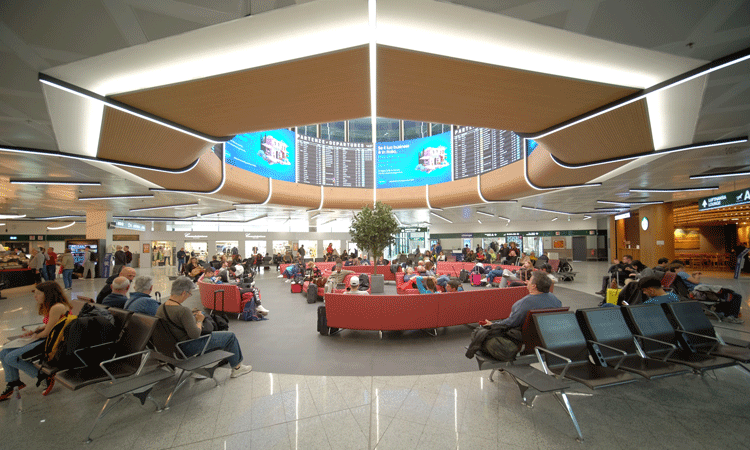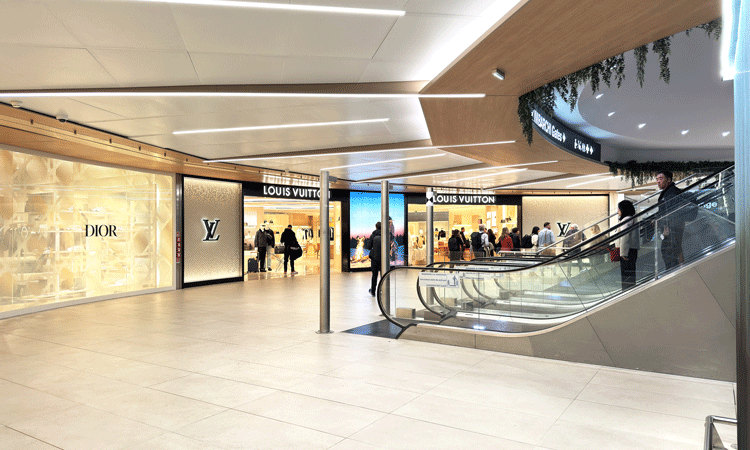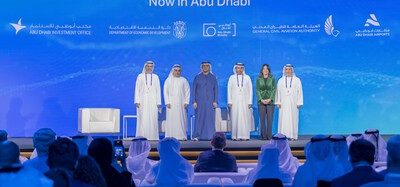Future-ready operations: Malpensa Airport launches Terminal 1 extension
Posted: 12 November 2025 | Alessandro Fidato | No comments yet
Alessandro Fidato writes for International Airport Review about Malpensa Airport’s T1XL project, which will expand Extra-Schengen facilities, enhance passenger comfort, introduce new retail spaces, and incorporate sustainable design and digital innovations for future-ready operations.


c: SEA Milan Airports
Project overview
Terminal 1 Extension (T1XL) at Milan Malpensa Airport marks a significant strategic investment by SEA, the operator of Milan’s Malpensa and Linate airports. With a total budget of approximately €85 million, the initiative forms part of the airport’s short/medium-term development strategy and aligns with the recently approved Masterplan 2035.
T1XL will enhance Malpensa’s capacity to manage intercontinental flows and elevate service quality for international travellers.
T1XL is designed to support Malpensa’s transformation into a modern, efficient and sustainable European hub, capable of meeting the evolving traffic demand and delivering a world-class passenger experience.
The project primarily addresses the growing demand for Extra-Schengen traffic, which is expected to rise substantially in the coming years. By expanding and upgrading key operational and commercial areas, T1XL will enhance Malpensa’s capacity to manage intercontinental flows and elevate service quality for international travellers.
Join us live: Shaping the Next Generation of Hold Baggage and Air Cargo Screening
Join us live for an insightful webinar on 11th December at 14:00 GMT, in collaboration with Smiths Detection, as we explore the strategic balance of operational efficiency, regulatory compliance, and sustainability in high-volume security environments.
This session offers a focused look into future-proofing your security strategy.
Key learning points
- Cost Reduction: Strategies to minimize bag travel time while simultaneously reducing operational costs.
- Regulatory Roadmap: Insights into the next wave of regulatory changes and their impact on future investment decisions.
- Sustainable Systems: Practical approaches to building sustainability into security systems and lowering the total cost of ownership (TCO).
- Scalable Solutions: Real-world examples of scalable systems supporting current airport growth and preparing for tomorrow.
Register now for expert insights, case studies, and actionable strategies on operational efficiency!
As the first phase of Terminal 1’s northern expansion, T1XL lays the foundation for future extensions of the Extra-Schengen zone. It includes the construction of 13,350 sqm of new space and the redevelopment of 28,650 sqm of existing areas, focusing on passport control (arrivals and departures), baggage reclaims, passenger services and commercial areas.


c: SEA Milan Airports
The new structure will be built atop a previously constructed underground shell and will feature a two-level elevation (arrival and departure). A flat roof will host an open-air parking deck, accessible via the departures-level viaduct.
Construction is scheduled to begin in late 2025 and conclude in early 2028, with phased delivery of operational and commercial areas. The timeline has been carefully planned to ensure uninterrupted airport operations throughout the construction period and to minimise any impact during the upcoming Milan-Cortina 2026 Winter Olympic and Paralympic Games, during which Malpensa will serve as Italy’s main Olympic gateway.
Enhancing passenger experience and capacity
The expansion introduces substantial improvements to the passenger journey, particularly for those travelling to or from Extra-Schengen destinations.
At the arrivals level:
- Passport control will be expanded with a 45% increase in queuing space, a 140% increase in manual control booths, and a 150% increase in automated e-gates
- The layout will align with current passenger flows and the positioning of Entry/Exit System (EES) kiosks
- In preparation for the Milano-Cortina 2026 Olympics, the corridor leading to passport control will be widened in a preliminary intervention that complements the T1XL works.
The Extra-Schengen baggage claim area will be extended to include three additional carousels, increasing the total from five to eight. A dedicated belt for oversized luggage will replace most manual handling procedures.
At the departures level:
- A new passport control zone will offer 15% more queuing space, 38% more manual booths and 50% more automated e-gates
- EES kiosks will be repositioned to optimise passenger flow
- After passport control, travellers will enter a spacious waiting area featuring seating, flight information screens, restrooms, a smoking lounge, and commercial services, providing comfort while awaiting gate calls.
This waiting area will serve as a strategic junction for Extra-Schengen departures and play a central role in future terminal developments, serving as the starting point of the connection to the future North Pier.


c: SEA Milan Airports
Commercial development strategy
A key objective of the T1XL project is to enhance the airport’s commercial offering. The departures level will host 21 new retail units totalling approximately 2,900 sqm.
A new retail gallery before passport control will extend the existing shopping corridor and offer passengers more opportunities to browse and relax.
Highlights will include a new retail gallery before passport control, extending the existing shopping corridor and offering passengers more opportunities to browse and relax. In addition, a commercial plaza beyond passport control will significantly upgrade premium services in the Extra-Schengen zone.
This new hub will strengthen core services such as duty-free, news stands, and food & beverage outlets; supporting passengers who remain near the gate area and providing assistance in case of flight delays.
To support commercial operations, a new underground security checkpoint for goods inspection will be introduced, along with storage facilities connected to retail units via dedicated freight elevators, ensuring efficient logistics and service continuity.


c: SEA Milan Airports
Architectural vision and design
The T1XL expansion is part of a broader architectural transformation of Terminal 1, initiated in the wake of the COVID-19 pandemic and continuing in anticipation of the Milan-Cortina 2026 Winter Olympics.
In view of the upcoming Winter Olympic and Paralympic Games, SEA has already launched several initiatives to enhance the image and functionality of the existing Terminal 1. These include restyling key piazzas and circulation nodes in the Schengen area, redevelopment of the arrival and departure forecourts, as well as renovation of the landside arrivals hall.
The goal is to present Terminal 1 as a modern, internationally competitive facility.
The new façade will feature continuous glazed surfaces with high energy performance and curved glass corners. Horizontal architectural bands will double as solar shading elements, while metallic cladding in warm, bronzed tones will add depth and elegance.
The external envelope is designed to harmonise with the existing terminal while asserting a contemporary identity.
The interior design emphasises comfort and emotional resonance, using warm colours and natural materials to create a welcoming atmosphere. A ceiling design inspired by nature will mimic sunlight filtering through tree canopies, using rhythmic aluminium slats and integrated lighting. Vaulted ceilings in the passport control queuing area will enhance spatial perception and reduce stress. Likewise, resin flooring with a terrazzo effect in soft tones will promote calm and spaciousness. The result is a refined, human-centred terminal aligned with Milan’s reputation for design excellence.


c: SEA Milan Airports
Sustainability, inclusive design, and digitalisation
Environmental sustainability is a cornerstone of the T1XL project. The expansion is designed in accordance with the BREEAM certification scheme, reflecting commitments to energy efficiency, responsible material use and low-impact construction.
A new photovoltaic system on the roof canopies of the adjacent parking structure, and the installation of LED lighting systems and water-saving fixtures throughout the terminal, will align with SEA’s sustainability aims. Materials used in the project will be selected in accordance with CAM (Minimum Environmental Criteria).
T1XL will see accessibility at Milan Malpensa equally prioritised. Barrier-free routes with clear signage and intuitive wayfinding, and dedicated passport control lanes for passengers with reduced mobility, will make Terminal 1 smoother for passengers to navigate.
Fully accessible restrooms with family-friendly amenities such as nurseries and child-sized toilets, plus seating areas with designated spaces and charging points for passengers with specific needs, will see every passenger provided for.
Technological innovation and digitalisation are integral to the project:
- Automated border control gates will be significantly increased in number across both arrival and departure zones
- Dynamic digital signage will manage passenger flows in real time
- Sensor-based technologies will monitor queue lengths and optimise resource allocation.
Together, these enhancements ensure a more efficient, inclusive and future-ready airport environment.
The author wishes to express sincere gratitude to SEA’s Infrastructure Development Team, and all the designers who have succeeded in interpreting the new identity of Malpensa Terminal 1, including Gnosis Progetti and F&M Ingegneria.


From December 2002 until June 2010, he worked for the Engineering firm of Autostrade per l’Italia S.p.A. (Atlantia Group) as Head of Transport Infrastructures.
In 2010, he joined Naples International Airport (2i Aeroporti) as Technical Director, becoming Operations Director and Accountable Manager from 2014 and Chief Operating Officer from January 2018.
Since March 2019, he is the Chief Operating Officer and Accountable Manager for SEA Milan Airports (Municipality of Milan and 2i Aeroporti), in charge of Milan Malpensa and Linate Airport.
He is a member of the Stakeholder Advisory Board (SAB) of EASA (European Aviation Safety Agency) and a member of the Governing Board of SESAR 3 Joint Undertaking; he is also Board President of the Transport, Logistic and Infrastructure Group of Assolombarda, Northern Italy’s entrepreneurial Association.
From October 2024, Fidato became Board President of Vertical Gateway S.p.A. (Ve.Ga.) A JV by SEA, Skyports and 2i Aeroporti, to lead Advanced Air Mobility in the Italian market.
From January 2025, he has been appointed a Voting Member of the Network Management Board (NMB) by a Decision of the European Commission.
Join our free webinar: Revolutionising India’s travel experience through the Digi Yatra biometric programme.
Air travel is booming, and airports worldwide need to move passengers faster and more efficiently. Join the Digi Yatra Foundation and IDEMIA to discover how this groundbreaking initiative has already enabled over 60 million seamless domestic journeys using biometric identity management.
Date: 16 Dec | Time: 09:00 GMT
rEGISTER NOW TO SECURE YOUR SPOT
Can’t attend live? No worries – register to receive the recording post-event.
Related topics
Airport development, Capacity, Digital transformation, Funding and finance, Innovation, Passenger experience and seamless travel, Sustainability, Terminal operations


















